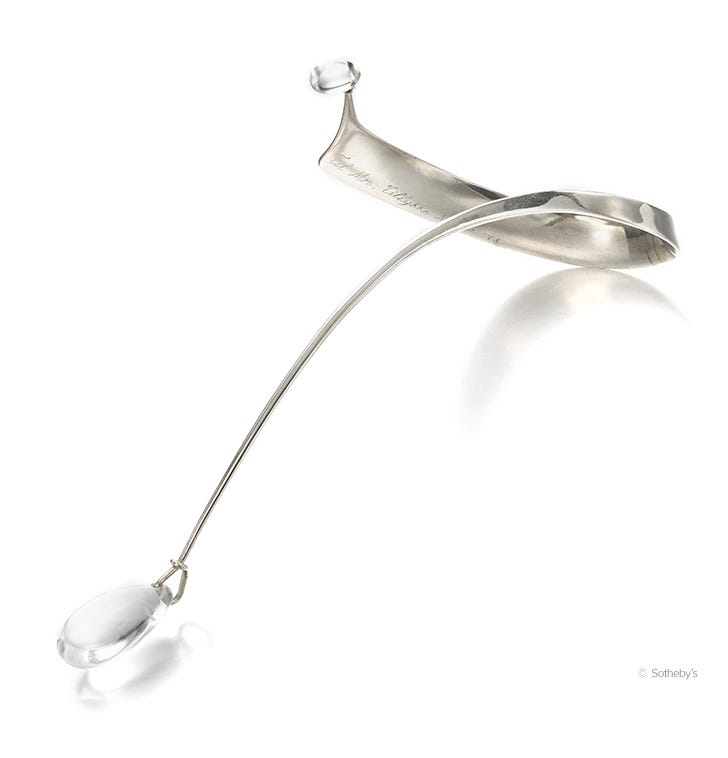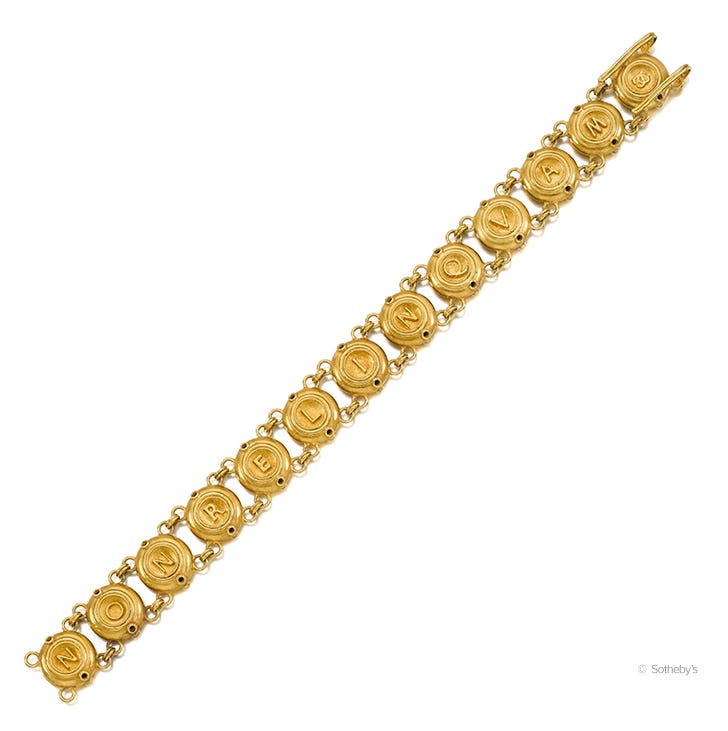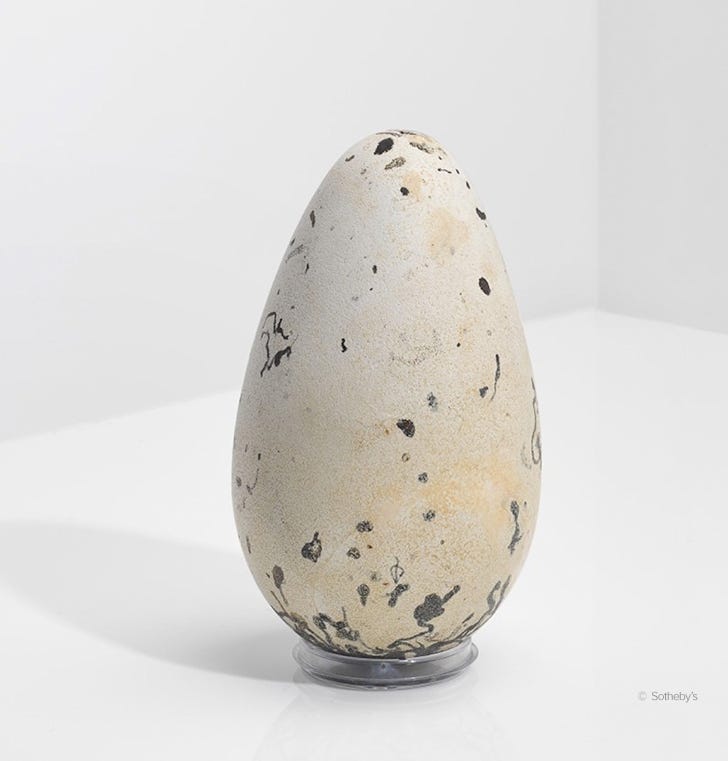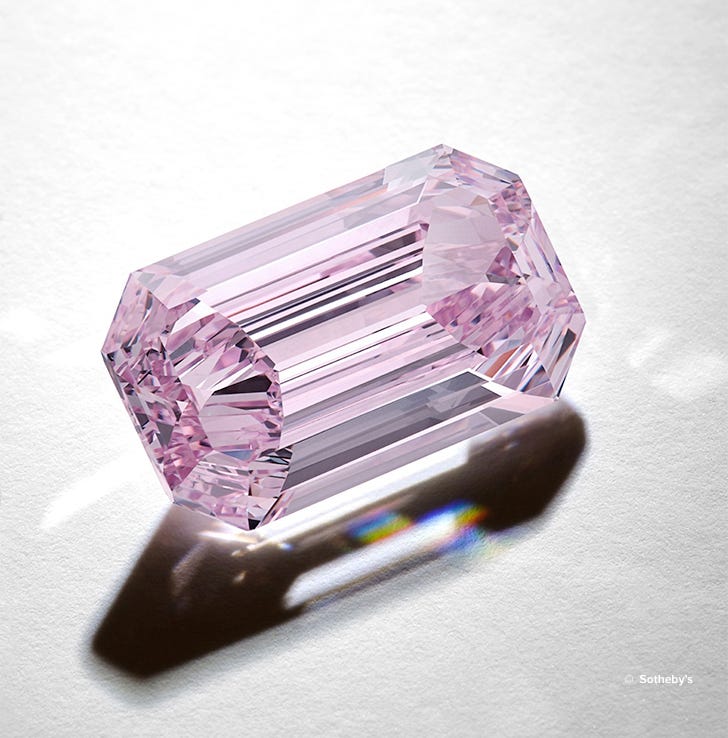Auk-ward! An antique egg, a Suffragette bow, and a truly gorgeous diamond
Also, stop here for all your mysterious jewelry side quests.
Hey guys, it’s New York City auction season! I’m sure you saw a lot of scornful coverage of Maurizio Cattelan’s duct-taped banana making $6.2 million at Sotheby’s last week. More power to him, I say. Cattelan’s been calling out the absurdity of the art world for years and the art world just keeps proving him right. And hell, anything that separates a crypto bro from $6.2 million is ok by me. (By the way, did anybody see the Cattelan retrospective at the Guggenheim a while back, where everything was hanging from the ceiling? That was AMAZING.)
Anyway, on to the stuff!
This ca. 1970s silver and rock crystal 'Mobile' necklace by Swedish silversmith Vivianna Torun Bülow-Hübe (1927–2004) is included in the Fine Jewels auction closing at Sotheby’s London today.
Torun, as she was usually known, was one of the greatest female silversmiths of the 20th century. She began making jewelry as a teenager and went on to settle in various cities throughout her life, setting up workshops in Stockholm, Paris (where she met painters Pablo Picasso, Georges Braque and Henri Matisse), Germany and finally, Indonesia.
In 1967, she became a freelance designer for the Georg Jensen Silversmithy and the piece above was made by them. It’s a great example of her work, which was renowned for its simple yet unconventional style. She once said, to quote a ridiculously heavy book I own called Georg Jensen Holloware: The Silver Fund Collection by David A. Taylor and Jason W. Laskey, that she wanted her jewelry “to be natural, anatomical: adapted to the movements of the human body, to slide up and down, back and forth on the arm.” An example of this philosophy is her 1958 “Mobile” necklace, a single continuous piece of silver topped with quartz that winds around the wearer’s neck and down onto the shoulder. Pieces like this led to her jewelry being described as “body sculpture.”
The elegant necklace above is a later spin on the concept, and it’s estimated at £6,000 - £8,000 GBP, or $7,500 - $10,000 USD.
Ok, I know I’m always going on about archaeological-revival jewelry and the Castellani and blah blah blah, but SURPRISE, I’m doing it again, nerds!!! Check out this circa 1870 Castellani bracelet that features 13 micro mosaic medallions set in gold. The medallions spell out NON RELINQUES, which means “you will not give up.”
And on the inside, against the skin, we have the words NON RELINQUAM, or “I will not give up.” That’s badass.
A version of this bracelet — without the micro mosaics — is in the collection of the Cooper Hewitt Museum in New York. They acquired it in 1964 and translate the inscriptions as “I will not forsake” and “You will not forsake,” wondering in their description if the slogans “may have had patriotic significance for the Castellani family, who were actively involved in the political upheavals in Italy during the middle years of the nineteenth century.” They certainly were, so who knows? It’s possible.
HOWEVER, I’m seeing a lot of shopping sites selling a gold-plated version of the bracelet that was apparently inspired by former First Lady Jacqueline Kennedy. According to these sites, Augusto Castellani was originally commissioned by the British Lord Layard to create the piece as a wedding bracelet for Layard’s wife, and, in a more romantic fashion, they translate the inscriptions as “I will never give up on you,” and “You will never give up on me.”
Again, according to these shopping sites, Castellani made two more bracelets: one for Gwendolyn Talbot, Princesse Borghese, and a third that was commissioned for Princesse de Bogali of Milan by her husband — who supposedly paid Augusto three times the cost of the piece on the condition that he never make another one.
So apparently Jackie Kennedy got wind of the Borghese bracelet and bought it at auction in 1983 for $170,000. (I haven’t been able to track this down yet, but I’m looking!) Her bracelet must have had red tesserae (the tiny stones that comprise the mosaic), because the costume version it inspired features red enamel in place of the micro mosaic. The Jackie connection must be real, because the gold-plated bracelet is apparently available in the gift shop of the Kennedy Center, but I can’t see what they say about it because the site is currently being “refreshed” until December 9.
Anyway, I’m thinking the Jackie bracelet looked like this one, which sold in the 2012 Sotheby’s Magnificent Jewels sale in Geneva for 18,750 CHF, or $16,600 USD. Could it be the same bracelet? I’m sure Sotheby’s would have mentioned the Kennedy provenance, so probably not.
It’s interesting that none of this wedding/aristocracy stuff shows up in any auction descriptions I can find — including the current one! — nor in the description of an all-gold version similar to the Cooper Hewitt bracelet that was sold by the highly respected London jewelers Wartski. It’s also not mentioned in Geoffrey Munn’s book Castellani and Giuliano: Revivalist Jewelers of the 19th Century, although a similar bracelet is pictured. That book was published in 1983, so too late for any Kennedy info, but still — nothing about weddings. Of course that doesn’t mean it’s false, I just haven’t tracked down any reputable sources yet.
So is it all marketing hooey or real? And are there really only three bracelets? Doesn’t look like it, since in my cursory search I’ve found one that’s been in the Cooper Hewitt since 1964, a similar one sold by Wartski presumably after 1964, a red-tesserae version sold by Sotheby’s in 2012, and now this current one, with ivory-colored tesserae.
The bracelet is included in the Sotheby’s Fine Jewels auction happening today, and it’s estimated at £6,000 - £8,000 GBP ($7,500 - $10,000 USD). If you’re interested, that sale contains many more exceptional archaeological- and Renaissance-revival pieces that were gleaned from a private collection.
The Christie’s Jewels Online: The London Edit sale ends on Friday, and it includes this beautiful ca. 1890 hair comb by Fabergé. The comb itself is tortoiseshell with an openwork gold mount in the form of a series of stylized and graduated leaves, each with a diamond-set flower nestled inside. The piece is marked for Fabergé on the mount with an additional scratched-on inventory number, and it still has its original fitted case (!!!). It’s estimated at £4,000 - £6,000 GBP ($5,000 - $7,500 USD).
This women’s suffrage brooch is included in the online Books, Manuscripts and Historical Photographs auction ending December 4th at Bonhams London. It takes the form of a white metal five-bar gate with the words “Only For One” enameled in purple, and it’s pinned to a homemade tri-color silk bow in white, green and purple (the official colors of the suffrage movement). The bow is attached to a purple armband.
Bonhams has added the footnote: “The brooch on this home-sewn armband would appear to be a rare piece as we have been unable to trace another similar one bearing this slogan.” And I agree — I’ve never seen one like this before, either, and god knows I’ve been rooting through auctions and antiques websites on the internet for far longer than I’d like to count.
The lot also includes a selection of women’s suffrage ephemera: 15 issues of Votes for Women from 1908 and 1909, 5 issues of The Suffragette newspaper, 1913-1914, and a novelty postcard depicting a cat dressed as a suffragette that’s postmarked February 1909. The group is estimated at £400 - £600 GBP, or $500 - $750 USD.
Interesting little mystery to snap up there, if anybody has the spare funds (I don’t) and needs a side quest.
Circa 1800, this is an egg of the extinct Great Auk (Pinguinus impennis).
Great auks were large (30-33 inches tall) flightless birds that lived and foraged in the waters of the North Atlantic. They bred on remote rocky islands, living in large colonies and mating for life. The female auk would lay one single egg per year, and both parents took turns incubating it and feeding the chick.
Unfortunately, because they were powerful swimmers but slow and clumsy on land, great auks were sitting ducks for European explorers who killed them in vast numbers for meat, fishing bait and down, while natural history collectors prized their eggs. As numbers dwindled, a far-too-late effort was launched to save the species and the last known pair were killed in 1844 on an island off the coast of Iceland.
So obviously this egg is extraordinarily rare, and thanks to a series of careful stewards, we know its history. It’s known as “Yarrell’s Egg,” after William Yarrell, a celebrated zoologist, bookseller and naturalist who was a contemporary and friend of John James Audubon, Charles Darwin and many others.
There are different tales as to how Yarrell found the egg. According to Sotheby’s, most “reputable” sources say he purchased the egg in a Parisian curiosity shop not long after 1815, but an anecdotal tale supposedly from Yarrell himself says he bought it for two francs from a “fishwoman” in a village near Boulogne.
Since then, it’s had a remarkable journey for something so fragile. According to Errol Fuller’s 1999 book The Great Auk,
“Yarrell kept the egg until his death in 1856 after which it was bought at Stevens’ [Auction Rooms] by the London taxidermist James Gardiner. Gardiner was acting on behalf of Mr. Frederick Bond of Kingsbury, Middlesex who paid £21 for it. During 1875 the egg was sold to Baron Louis d’Hamonville who took it to France but in 1894 it was back at Stevens’ where it was sold to Sir Vauncey Crewe of Calke Abbey, Derbyshire for 300 guineas. In 1925 the egg visited Stevens’ for a third time and was bought by a Mr. Hirch for five guineas more than it cost in 1894. Then it passed through several more hands – A.T. Wilson, F.G. Lupton, and the Reverend F.C.R. Jourdain before being acquired by Captain Vivian Hewitt. Following Hewitt’s death in 1965 the egg languished in a cupboard at the London headquarters of Spink and Son before being bought, in 1993, by Dr. Jack Gibson.”
Fuller is a British author and artist who has written a series of books on extinct birds, including the great auk, the dodo and the passenger pigeon. He purchased Yarrell’s egg from Dr. Jack Gibson in 2008 and deeply researched its provenance for his book, providing extensive documentation, photos and illustrations to fill out its history.
The egg’s present owner bought it from Fuller in 2010, and now it’s landed in the Treasures live auction at Sotheby’s London on December 4th. It’s estimated at £50,000 - £70,000 GBP, or $63,000 - $88,000 USD.
SO, it’s time for the big fancy Magnificent Jewels auctions in New York Citay, and first up is Christie’s on December 10. The showstopper is a 5.72 carat fancy intense blue diamond set in a platinum and diamond band. It’s estimated at $6 million to $8 million.
That’s fine and everything, but the cuff bracelet above stopped me in my tracks. It’s circa 1925, by Georges Fouquet. Georges was the second generation member of a family of Parisian jewelers who navigated the evolution of the flowy Art Nouveau style into the angles of Art Deco so successfully they’re seen as masters of both. (If you’re new here, check out this 2022 post that included Georges’ Art Nouveau “Wings” brooch from 1907-1908.)
The bracelet is layered with lines. First, horizontal bands of black enamel circle the 18k cuff. Over the bands, lines of old- and single-cut diamonds shoot off at various angles, and they in turn are overlaid with vertical strips of rectangular-shaped orange topaz. The piece is crowned by a cabochon emerald.
It’s signed G. Fouquet, “d'après dessin de A.léveillé,” which I believe means that this piece was one that Fouquet designed with the help of Cubist painter and designer André Léveillé. Fouquet was known to seek out and collaborate with emerging artists, which is one of the reasons the firm was able to successfully move from the older, romantic styles into the new Modernist world.
The bracelet is estimated at $150,000 – $250,000 USD.
The next day is Sotheby’s turn. Their Magnificent Jewels auction features this emerald-cut Fancy Intense Purplish Pink diamond — and you know I’m not a big diamond person, but man, that thing is pretty. It’s 7.00 carats and internally flawless and set in a ring by New York jeweler Valentin Magro (but they don’t show that part). It’s estimated to sell for $3,250,000 - $4,250,000.
That’s it for today, pals. I hope my fellow Americans have a happy Thanksgiving, and everyone else enjoys the short break from our bullshit. Also, thank you to the one person (bison?) in South Dakota who recently signed up for this newsletter — now I can finally say that Dearest is read in all 50 US states and 96 countries. That blows my tiny little mind.
Thanks, everybody. Stay well! M x












Please write a book. Please.
I love your newsletters so much, I pore over every little thing with my morning tea.